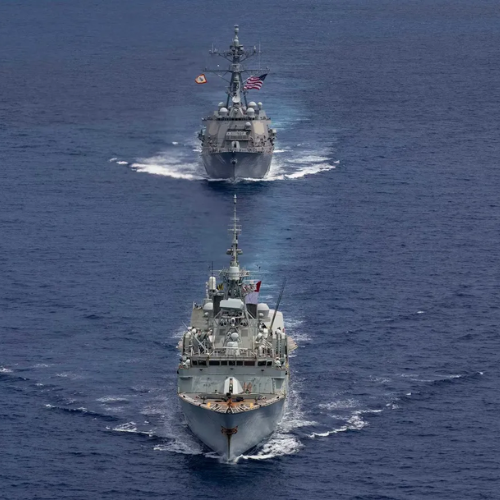In the South China Sea, tensions have been growing, and recently, the Canadian and U.S. navies came together to carry out joint exercises. This military activity took place from January 8 to 11, 2025, involving the Canadian warship HMCS Ottawa and the U.S. Navy destroyer USS Higgins. Both ships participated in a series of important training exercises in the disputed waters, showing a strong presence in the region.
Military Drills in the South China Sea
The joint drills, known by the code name “Noble Wolverine,” were designed to improve the communication and operational skills between the two naval forces. These exercises are not uncommon but are especially significant due to the growing military activity in the South China Sea, a region known for its disputed waters and strategic importance. The military ships conducted several operations during the drills, including communications exercises, flight operations, and anti-submarine warfare training.
The South China Sea is considered an international waterway, meaning that ships from different countries are allowed to pass through it. However, many countries, including China, have overlapping territorial claims over parts of the sea, leading to increased tensions in the area. The exercises were conducted in these waters to highlight the importance of international freedom of navigation and to ensure that military forces can work together effectively in such a complicated and sensitive region.
Navigating Close to Disputed Waters
During the drills, the HMCS Ottawa, which is a Halifax-class frigate, sailed close to the Scarborough Shoal. This location has been a point of constant dispute between China and the Philippines. The Scarborough Shoal is part of a chain of reefs located within the Philippines’ exclusive economic zone (EEZ), but China has controlled the area de facto for years.
The Philippine coast guard has frequently clashed with Chinese forces in this area, with both countries trying to assert their control over the shoal. The presence of the Canadian and U.S. warships in the region was seen as a statement of support for the Philippines, though the waters remain a contentious zone. As the two warships sailed nearby, Chinese naval ships closely followed them, further highlighting the delicate nature of operations in this area.
Rising Tensions in the Region
The situation in the South China Sea has been tense for months, with escalating confrontations between China and other countries like the Philippines. One major development in early 2025 was the arrival of China’s largest coast guard ship, known as “The Monster,” to the region. The ship has a reputation for its immense size and is being deployed by China in what the Philippines has called an act of intimidation.
The Philippines has been critical of China’s aggressive actions in the South China Sea, viewing them as acts of coercion and bullying. Beijing’s military and coast guard presence in the region has been a cause of concern for countries that rely on the sea lanes for trade and navigation. These tensions were evident during the joint drills, with both Canadian and U.S. warships navigating through international waters while Chinese ships shadowed their every move.
While the presence of foreign warships in the region is not new, the increased military activity by China has made these operations more delicate. The Canadian and U.S. naval forces are committed to maintaining the principle of freedom of navigation in international waters, but their activities come with the risk of further provoking China, which has strong territorial claims in the area.
The military drills between the U.S. and Canada are a clear signal that these two countries are prepared to defend the principle of free passage through international waters, especially in regions where territorial disputes are heated. The joint exercises show that Canada and the United States are committed to upholding their military alliances and ensuring stability in the region, despite the challenges posed by rising tensions in the South China Sea.

